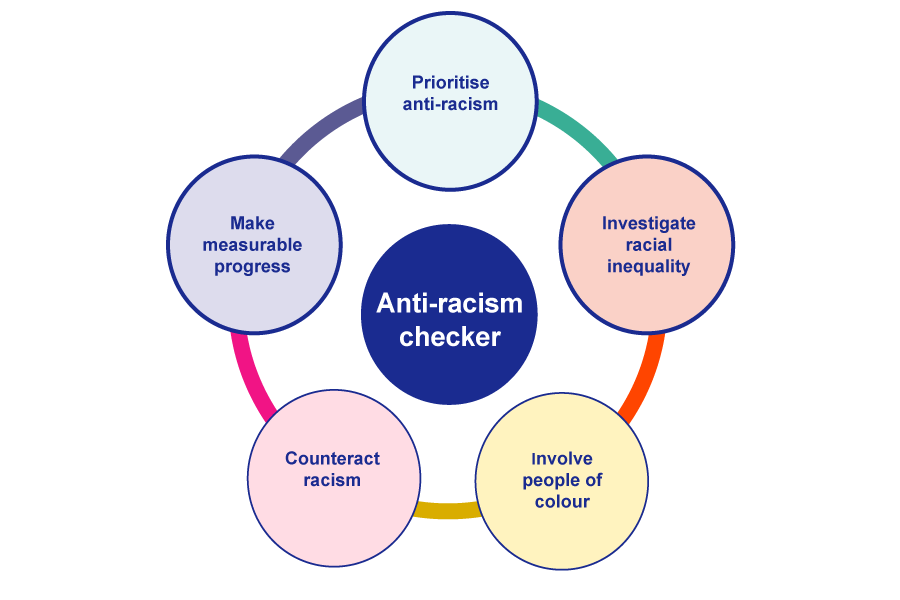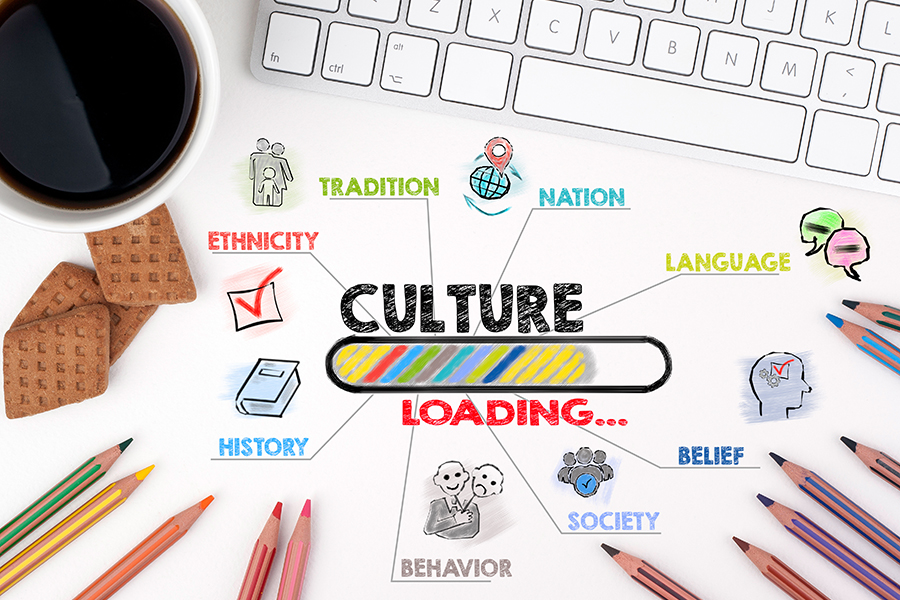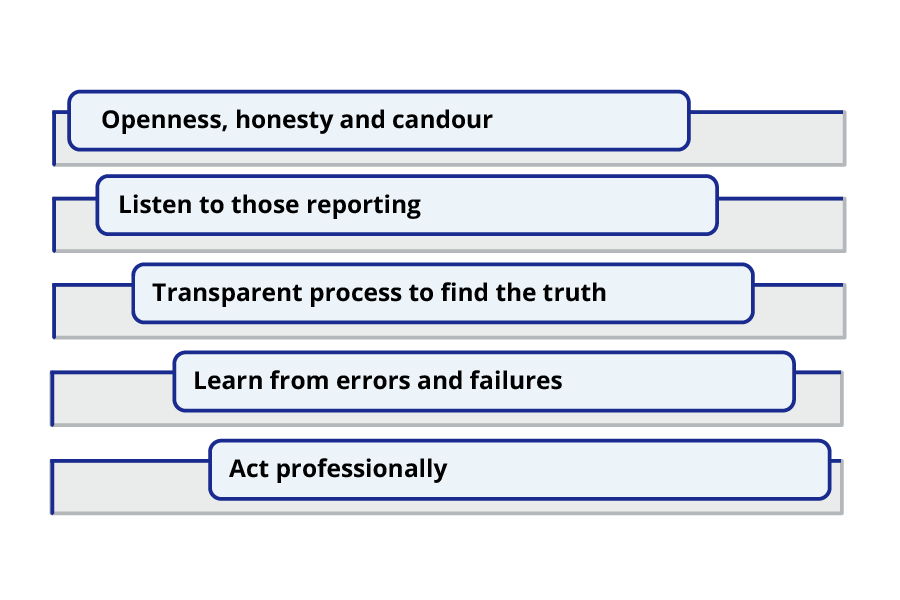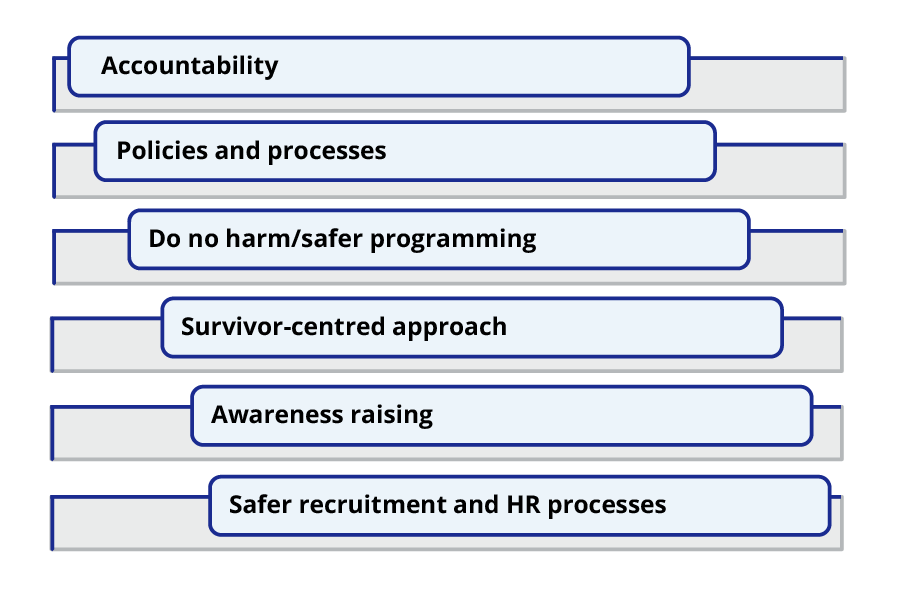Unit 2: The importance of a safe organisational culture
| Site: | OpenLearn Create |
| Course: | Leadership in Safeguarding in the International Aid Sector |
| Book: | Unit 2: The importance of a safe organisational culture |
| Printed by: | Guest user |
| Date: | Friday, 21 November 2025, 6:30 AM |
Table of contents
- Introduction
- 2.1 Are organisational values aligned with safeguarding principles?
- 2.2 How do leaders promote a positive organisational culture?
- 2.3 Barriers to change – racism and discrimination
- 2.4 Why equality, diversity and inclusion in workspaces matter
- 2.5 Anti-racism and discrimination checker
- 2.6 Transforming organisational culture
- 2.7 Learning from our blind spots
- 2.8 Embedding a ’learning’ and not a ’blaming’ culture
- 2.9 Strong safeguarding cultures among leaders
- 2.10 Strong safeguarding cultures among leaders
- 2.11 Unit 2 Knowledge check
- 2.12 Webinar 1
- 2.13 Review of Unit 2
Introduction
This unit reflects on how to improve organisational culture to support the safeguarding of all persons, including identifying barriers to a positive organisational culture and practices which give rise to safeguarding concerns.
2.1 Are organisational values aligned with safeguarding principles?
Safeguarding is not just about policies, procedures and practices – although this is essential. It is also about having the organisational culture that does not tolerate all forms of harm, particularly SEAH.
Culture can be difficult to articulate and particularly challenging for those within the organisation to assess. ‘Organisational culture’ is often described as the personality of an organisation and as ‘the way we do things around here’. It encompasses the underlying values, beliefs and codes of practice that make an organisation the unique entity it is.
It is expressed through the organisation’s vision, mission statement and values, and can be seen through behaviour, language, customs, rules, group interaction and habits (Williams, 2018). It gives a sense of identity to employees and tacitly provides guidelines on how to get along in the organisation.
Setting, monitoring and reviewing organisational culture is pivotal to effective safeguarding. The way organisations treat their staff reflects on how they treat their partners and those they seek to help (for example, clients, beneficiaries, communities, partners). Organisations should provide spaces for their staff to speak up and listen to suggestions, opinions and concerns regarding safety and wellbeing.
Most especially, organisations should convey the message that concerns related to any mistreatment will be addressed. This is important because an unsafe workplace can lead to unsafe programming and ways of working, leading to harm, abuse, exploitation, and harassment. In unit 1 you learnt how the role of leaders is pivotal, as they should lead by example and foster good relationships with their staff and between their staff.
2.2 How do leaders promote a positive organisational culture?

A positive organisational culture establishes behaviours that support safeguarding.
It would be challenging for organisations who have not reflected internally on their own behaviour to then inform partners and others how to behave when delivering programmes or other forms of organisational activities. To be effective and successful, an organisational culture needs to embed and practise its values and behaviours. They should be articulated at every level of an organisation, particularly by the leadership team.
Leaders need to lead by example and should allow themselves to be held to account. Bond (n.d.), a network of international development organisations in the UK, identified the following practical ways that leaders can have an impact on organisational culture:
- The extent to which their words match their deeds and how this is handled when they don’t.
- The way in which they are seen to handle failure.
- The way in which their values are seen to be lived and acted out.
- The way in which their interactions and relationships with other senior managers are experienced by the wider organisation.
- The decisions they make about who is hired and who is fired, and why.
- The decisions they make about who is valued and rewarded, who isn’t, and why.
- The systems and processes that they champion and prioritise.
However, recent failures in safeguarding in the international aid sector have shown that leaders and organisational cultures are not delivering good safeguarding practice and that people do not feel safe and empowered to report concerns when they arise (Bond, 2021). Reports of feeling unsafe are particularly common among people of colour who work for our organisations, including those in the countries we serve.
The resurgence of the Black Lives Matter campaign, following the murder of George Floyd by US police in 2020, has shone a spotlight on racism in mainly Western-based organisations and the international aid sector has not escaped public and donor scrutiny.
It has given rise to questions around why it is that people of colour find it difficult to get jobs in the international aid sector, to advance in their roles in aid organisations, and to reach management positions or at least roles with decision-making powers?
|
Activity 2.1 Experiences of racism Read the executive summary of the Bond report Racism, power and truth: Experiences of people of colour in development. Then answer the following questions, noting your ideas in your learning journal: Identify some examples of racist practices and attitudes that you have observed or experienced in your working life.
Please note that the report, particularly the personal testimonies of discrimination, may be very challenging to read. Think about what sources of support you have within or outside your own organisation. |
2.3 Barriers to change – racism and discrimination
![]()
Watch the video above, Racism, power and truth, produced by Bond that provides testimony from people of colour working in our sector. It tells of their experiences of racism and discrimination and their lack of power to bring about change.
Do the testimonies resonate with your experiences or of others you have known?
The term BAME (Black, Asian and Minority Ethic) is used interchangeably to denote people of colour in the video.
Not only does ‘whiteness’ characterise many staff within our organisations, particularly at head office, but the international aid sector is also accused of doing development through a ‘white gaze’.
This holds Western approaches to development as the standards to which all should aspire. Whilst our organisations seek to help people of colour in low-resource settings around the globe, the in-country senior management teams are invariably white expatriates.
This has led to calls to shift away from our ‘white gaze’, critiquing the white, western framing of development and advocating mainstreaming racial tolerance in our understanding of development to overcome the ‘white-gaze’ problem (Pailey, 2019).
Only when each of us questions our position within development and our inherent subjectivity can development become racially aware and power inequalities and hierarchies be effectively challenged (Kothari, 2006).
This video accompanies the report Racism, power and truth: Experiences of people of colour in development. You will see one of its authors - Lena Bheeroo, Engagement & Equity Manager, BOND. - discussing this report in the webinar later in this unit.
2.4 Why equality, diversity and inclusion in workspaces matter
Studies show that organisations that are more diverse and inclusive in recruitment and approach tend to be successful. They attract the best talent, as talented individuals want to work in organisations where they see people like themselves represented, particularly in top leadership positions.
Under representation of some groups (particularly those from the beneficiary group that the organisation may be working in) risks missing significant talent pools and the diverse perspectives they can bring to an organisation.
Such a group may be people of colour in a Western-based organisation. They may experience harassment, discrimination and microaggressions at work simply because they are different. Microaggressions are the expression of hostile, derogatory or negative attitudes toward stigmatised or culturally marginalised groups and others.
Colleagues of different ethnicities, religions, gender identity, sexual orientation, socio-economic background, disability and age can also be discriminated against, or fail to get on in the organisation and advance to management positions.
In many countries there are laws protecting these characteristics so that discrimination can be challenged. Nevertheless, this may not be universal. This has led to aid organisations developing policies that seek to address greater equality, diversity and inclusion (EDI) because an unequal workplace can lead to an unsafe culture with attendant safeguarding concerns.
However, as had already been highlighted, policies alone are not enough to change an organisational culture. Change requires the living and breathing of an appropriate set of values.
|
Activity 2.2 The value of diversity Consider the following questions and make some notes in your learning journal:
|
![]()
Want to find out more?
To learn more about this topic, follow the link below:
ActionAid UK sorry after internal report finds ‘denial, disbelief or indifference’ to racism
2.5 Anti-racism and discrimination checker
However well-meaning we are and objective we try to be, we all have and exhibit bias consciously or unconsciously.
Because of this, we should check our power and privilege and be more aware of possible discrimination and racism in our organisations which make unsafe workspaces.
To overcome the possible misuse of power and privilege and to bring about effective change, an innovative tool is needed which will help shift the focus from individual intent to be fair to fair and equitable outcomes. Only when staff and local partners feel sufficiently confident to speak up and challenge leaders will our organisations have effectively tackled racism.
This tool, developed by Wellcome, Britain’s biggest charity, enables the systematic tracking of progress towards tackling racism. The tool is based on five anti-racist principles (shown in the diagram below) against which progress is tracked.

As anti-racism is a cross-organisational activity, the tool includes a section to record who you have shared reflections and progress with. The tool could be adapted to address discrimination also.
|
How do you think your organisation could make use of this tool? |
This may be an issue that you need to discuss with other people in your organisation in order to think about how it could be used effectively.
2.6 Transforming organisational culture
Building the capacity or composition of the Board may be needed to transform organisational culture.
According to studies, 34% of the largest 100 charities in the UK have no representation from ethnic minority communities in their leadership team, while women occupy just 27.5% of chair, chief executive, and chief financial officer positions, despite making up 65% of the workforce in the sector (Williams, 2018).
As mentioned, changing the composition of Boards and senior management teams to facilitate EDI and effective safeguarding, whilst fundamental, will not be easy. It means starting to have open conversations. Such conversations can be uncomfortable as they involve shifting power and countering the privilege and entitlement of those in power.
Diversity at Board level and among the senior management team is important to counter racism and inequality and encourage inclusiveness. It is also important to discourage ‘groupthink’, where poor decisions go unchallenged because everyone thinks in a similar way about an issue.
Encouraging existing long-term Board members, within the terms of the organisation’s Constitution, to retire at the end of their term could be seen as a loss of their power, privilege and entitlement, and may be resisted. But Boards have a crucial role to play in transforming organisational culture, most especially in recruiting the Chief Executive Officer and the senior management team. If they are predominantly of the same ethnic group, or age, or background, they are likely to hire people who look or think like them.
To be well placed to evaluate the best candidates, Boards need lived experience of the challenges of development in low-resource settings and to understand the importance of EDI for the future of the organisation’s growth.
More about this in unit 4 of the course.
2.7 Learning from our blind spots
One of the best ways of learning and bringing about change is reviewing past mistakes, near misses and blind spots in relation to safeguarding.
You will learn more about carrying out impartial safeguarding investigations into alleged misconduct in unit 3. Such investigations not only address the misconduct but can serve to eliminate further risk. Investigations can be carried out even if the survivor or victim wishes to remain anonymous, since it is the action/behaviour that is being investigated and not the Subject(s) of the Complaint personally.
Investigations into near misses allow an organisation to understand how the policies and practices worked, ‘just’, but also to identify the weaknesses and breaking points that could lead to a very different outcome next time. Blind spots are where signs of risk are missed, or data is not collected or analysed effectively.
2.8 Embedding a ’learning’ and not a ’blaming’ culture

It’s imperative that organisations embed a culture of learning rather than blame. In other words, clarifying how organisational ways may cause harm, being respectful, factual, transparent and accountable.
It involves building a non-permissive environment, where wrongdoing is not tolerated, and living and breathing the mission and values of the organisation.
The elements of a learning culture are shown in the following diagram.

Following these elements to guide the learning process could prevent further harm from occurring and support new learning to be communicated across the organisation and with stakeholders.
The learning should also be included in organisational safeguarding policies and practices to demonstrate accountability to the donors, partners, and beneficiaries you work with, but should also be constantly evolving in response to new learning.
2.9 Strong safeguarding cultures among leaders
Leaders may still struggle to know what a strong safeguarding organisational culture to keep people safe looks like in practice.
|
Activity 2.3 Case study – harassment in the workplace Read the case study below and then reflect on the questions that follow. Ann is a woman of colour working as a caseworker with a small UK-based charity (NGO) that helps refugees from other parts of the world. Other staff at the charity include Adam – another caseworker, Jenny – the administrative assistant, and Philip – the manager. Everyone reports to Philip, who reports to the Board of Trustees. Slowly, Ann realises that Adam ignores her in the coffee room and shows a lack of respect for her in team meetings, talking over her when she makes a contribution to discussions. Ann has also heard Adam making racist comments about some of the refugees they work with. Ann asks Jenny if she has noticed the way Adam behaves towards her. Jenny shrugs and responds that he is a bit “bigoted” and ‘’probably racist’’. Ann asks for a meeting with Philip and shares with him her concerns. Philip speaks to Adam at a football match and asks him to be careful what he says around Ann because she is “a bit hyper-sensitive”. Adam neglects to include Ann in group meetings, avoids her in the coffee room and is very officious with her. Ann quits a few months later and takes a job in a larger NGO. Philip does not bring this issue to the attention of the Board. (Adapted from Bond, 2019) Consider these questions in light of organisational culture, policies and procedures:
|
2.10 Strong safeguarding cultures among leaders
Whilst this unit has presented the case for a strong safeguarding organisational culture, leaders may still struggle to know what this looks like in practice and to understand the strengths and weaknesses of their own organisational culture.
Bond’s Safeguarding Leadership tool aims to bridge that gap. It is a discussion-based tool that support leaders to:
- Assess their organisational culture in relation to safeguarding.
- Understand what a positive safeguarding culture looks like.
- Develop behaviours to help prevent all types of harm, including sexual exploitation, abuse and sexual harassment (SEAH) in their organisations and those associated with their organisations.
The tool is broken down into six sections, as shown in the diagram below, with each section focusing on different aspects of a positive safeguarding culture.

There is no set order to progress through the different elements, and leadership teams should start with what they feel is the most pertinent for their organisation.
Through a series of questions for each element, the leadership team will be able to evaluate their own understanding and practice, before considering the behaviours that the tool recommends for improvement.
The tool has a space to archive the learning and to facilitate further reflection and discussion.
Please visit the Leadership Tool now and consider how it might be useful in your own organisation.
![]()
Want to find out more?
For further reading on this topic, follow the links below:
- Scotland’s International Development Alliance (2022) Reflecting on language in international development in Scotland - Discussion paper version 2
- Cooney, R. (2022) ActionAid UK sorry after internal report finds ‘denial, disbelief or indifference’ to racism
2.11 Unit 2 Knowledge check

The end-of-unit knowledge check is a great way to check your understanding of what you have learnt.
There are five questions, and you can have as many attempts at the quiz as you like. The quizzes at the end of each unit count towards achieving your Digital Badge for the course. You must score at least 80% across all the quizzes. You can re-take all of the quizzes as many times as you like.
2.12 Webinar 1
|
This webinar explores the issues of leadership and organisational culture that are covered in Units 1 and 2 of this course. A recording of the webinar (58 minutes) is available for you to watch below. Each of the speakers approaches the topic from a different perspective, please note in your learning journal any key points from each that you would like to take back to discuss in your own organisation. Topic: Leadership skills & EDI Speakers:
IDC report on Racism in the Aid Sector |
2.13 Review of Unit 2

This unit has explored organisational culture, and why it is pivotal to the organisation’s approach to safeguarding.
Strengthening diversity and inclusion is a way to enable all staff to feel valued and safe as it should address inequality within organisations and the sector as a whole. Building an internal safeguarding culture makes the workplace safer and leads to safer programming and ways of working.
Leaders are pivotal to shaping an organisation’s safeguarding culture and are responsible for effectively managing and ensuring continuous improvement in safeguarding policies, practices and behaviours.
|
From any of the learning in this unit, try and identify three things that you might take away from the course in relation to leadership. |
Now go to Unit 3: Reporting, responding and investigations.
References
Bond (2019) Safeguarding report handling mechanism Case studies [Online]. Available at Bond.
Bond (2021) Racism, power and truth: Experiences of people of colour in development [Online]. Available at Bond.
Bond (n.d.) FAQs [Online]. Available at Bond.
Hunt, J. (2016) From a blame culture to a learning culture, Address to the Global Patient Safety Summit on improving safety standards in healthcare [Online]. Available at Gov.uk.
Kothari, U. (2006) An agenda for thinking about ‘race’ in development, Progress in Development Studies, 6(1), pp. 9–23 (doi: 10.1191/1464993406ps124oa).
Maheshwari-Arpin, P. (2021) Being non-binary in the UK today [Online]. Available at Stonewall.
Pailey, R. (2019) De-centring the ‘white-gaze’ of development, Keynote address to the Development Studies Association, held at The Open University in June 2019.
UK Government (2015) Learning not blaming. The government response to the Freedom to Speak Up consultation, the Public Administration Select Committee report, Investigating Clinical Incidents in the NHS, and the Morecambe Bay Investigation. [Online]. Available at Gov.uk.
Williams, A. (2018) A respectful organisational culture is crucial to safeguarding [Online]. Available at Bond.